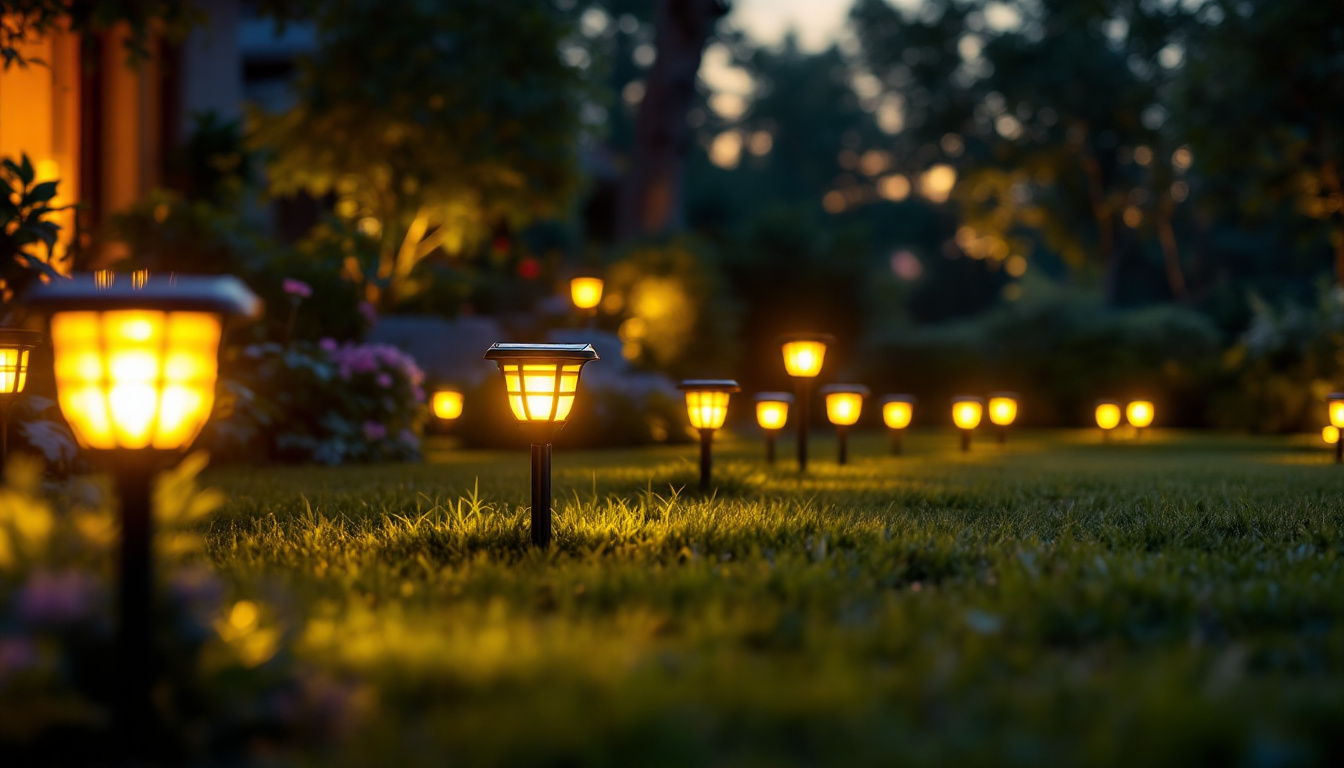
As the demand for sustainable and energy-efficient solutions continues to rise, solar lighting has emerged as a popular choice for illuminating lawns and outdoor spaces. For lighting contractors, understanding the nuances of solar lights is essential for providing clients with effective and aesthetically pleasing solutions. This article delves into the key aspects of solar lights for lawns, offering insights that can enhance project proposals and client satisfaction.
Solar lights operate by harnessing sunlight and converting it into electricity. Each unit typically consists of a solar panel, a rechargeable battery, an LED light, and a controller. During the day, the solar panel absorbs sunlight and converts it into electrical energy, which is stored in the battery. As dusk falls, the controller activates the LED light, illuminating the area without drawing on the grid.
This self-sustaining mechanism not only reduces electricity costs but also minimizes the environmental impact, making solar lights an attractive option for eco-conscious clients. Understanding this basic functionality is crucial for lighting contractors, as it allows for informed discussions about the benefits and limitations of solar lighting systems. Furthermore, advancements in solar technology have led to improved efficiency in solar panels and batteries, enabling longer operational hours and brighter outputs. Some modern solar lights even come equipped with smart technology, allowing users to control brightness levels and set timers through mobile applications, enhancing both convenience and energy management.
Solar lights come in various types, each designed for specific applications. Some of the most common types include:
Each type has its own unique features and benefits, allowing contractors to tailor their recommendations based on the specific needs of their clients. Additionally, solar lights are available in various styles and finishes, catering to diverse aesthetic preferences. For instance, sleek, modern designs can complement contemporary landscapes, while vintage-inspired fixtures can enhance the charm of traditional gardens. The versatility of solar lighting not only meets functional requirements but also allows for creative expression in outdoor design, making it an essential consideration for any landscaping project.
One of the most compelling advantages of solar lights is their cost-effectiveness. Once installed, they require little to no maintenance and eliminate ongoing electricity costs. This financial benefit can be particularly appealing to clients who are looking to reduce their energy bills or invest in long-term solutions.
Moreover, the initial investment in solar lighting can often be recouped within a few years, depending on usage and local electricity rates. For contractors, presenting this information can help clients see the value in choosing solar options over traditional lighting systems. Additionally, many solar lights come with warranties that guarantee performance over a specified period, further assuring clients of their investment’s durability and reliability. This peace of mind can be a significant selling point, as clients are often hesitant to invest in new technologies without understanding their long-term benefits.
Solar lights contribute to a reduction in carbon footprint by utilizing renewable energy. This aligns with the growing trend of sustainability in landscaping and outdoor design. Clients are increasingly aware of their environmental impact, and offering solar lighting solutions can position contractors as forward-thinking professionals committed to eco-friendly practices.
Additionally, solar lights do not require extensive wiring or trenching, which minimizes disruption to the existing landscape and protects local ecosystems during installation. The absence of electrical connections also means that solar lights can be placed in remote or hard-to-reach areas of a lawn, allowing for creative lighting designs that enhance the beauty of the landscape. Furthermore, many solar lights are designed with energy-efficient LED bulbs that not only last longer but also emit a softer, more aesthetically pleasing glow, creating an inviting atmosphere for outdoor gatherings and evening relaxation.
Before installation, a thorough site assessment is crucial. Factors such as sunlight exposure, landscape features, and the intended use of the space must be evaluated. Solar lights require direct sunlight to function optimally, so areas shaded by trees, buildings, or other structures may not be suitable for solar installation.
Contractors should also consider the layout of the lawn and how the lights will enhance visibility and aesthetics. A well-planned installation can significantly improve the effectiveness of the lighting and the overall satisfaction of the client.
When selecting solar lights for a project, it is essential to consider quality and performance. Not all solar lights are created equal; factors such as battery capacity, lumens output, and durability should be taken into account. High-quality solar lights will typically have a longer lifespan and better performance, ensuring that clients receive a reliable product.
Contractors should also be aware of the various features available, such as motion sensors, adjustable brightness, and color temperature options. These features can enhance the functionality of the lights and cater to the specific preferences of clients.
While solar lights are generally low-maintenance, some care is still required to ensure optimal performance. Regular cleaning of the solar panels is essential to remove dust, debris, and snow, which can obstruct sunlight absorption. Additionally, checking the battery condition periodically can help identify any potential issues before they affect performance.
Contractors should advise clients on the best maintenance practices to extend the lifespan of their solar lights. This can include seasonal checks and cleaning schedules, which will not only keep the lights functioning efficiently but also enhance the aesthetic appeal of the outdoor space.
The lifespan of solar lights can vary significantly based on quality and environmental factors. Generally, high-quality solar lights can last anywhere from 3 to 10 years. The LED bulbs used in solar lights are particularly long-lasting, often exceeding 25,000 hours of use. However, the battery’s lifespan is typically shorter, usually ranging from 1 to 3 years.
Understanding these longevity factors can help contractors set realistic expectations with clients regarding the lifespan of their solar lighting systems. Proper maintenance can significantly extend the life of both the lights and the batteries, ensuring that clients receive the best value for their investment.
Solar lights can dramatically enhance the visual appeal of outdoor spaces. They come in various designs, colors, and styles, allowing contractors to recommend options that complement the existing landscape and architecture. From modern to traditional styles, there is a solar light solution for every aesthetic preference.
Incorporating solar lights into landscaping can create a magical ambiance, especially in gardens and patios. By strategically placing lights to highlight pathways, plants, and architectural features, contractors can help clients achieve a beautifully illuminated outdoor space that is both functional and inviting.
Many solar lights offer customization options, such as adjustable brightness levels and color-changing features. This flexibility allows contractors to tailor the lighting experience to the specific needs and preferences of their clients. For instance, a client may prefer brighter lights for security purposes in certain areas, while opting for softer, warmer lights for entertaining spaces.
By discussing these customization options with clients, contractors can provide a more personalized service that enhances client satisfaction and fosters long-term relationships.
One common misconception is that solar lights are ineffective in cloudy or rainy weather. While it is true that solar lights rely on sunlight, modern solar technology has improved significantly, allowing lights to perform well even in less-than-ideal conditions. Many solar lights can store enough energy to function for several nights, even with limited sunlight exposure.
Contractors should educate clients about the performance capabilities of solar lights, emphasizing that while optimal performance is achieved with direct sunlight, advancements in technology have made solar lights a reliable option year-round.
Another misconception is that solar lights are too expensive to justify their installation. While the upfront costs may be higher than traditional lighting options, the long-term savings on energy bills and maintenance can far outweigh the initial investment. Additionally, many clients may be eligible for rebates or incentives for choosing energy-efficient solutions, further offsetting costs.
By clearly communicating the long-term financial benefits of solar lighting, contractors can help clients make informed decisions that align with their budget and sustainability goals.
Solar lights offer a multitude of benefits for lawns and outdoor spaces, making them an excellent choice for lighting contractors looking to provide sustainable and cost-effective solutions. By understanding the technology, installation considerations, maintenance practices, and design options, contractors can enhance their service offerings and meet the evolving needs of their clients.
As the demand for eco-friendly solutions continues to grow, embracing solar lighting technology can position contractors as leaders in the industry, ready to deliver innovative and efficient lighting solutions that illuminate outdoor spaces beautifully and sustainably.
Ready to elevate your lighting projects with sustainable and cost-effective solar solutions? Look no further than LumenWholesale, where we provide lighting contractors with the highest quality, spec-grade lighting products at unbeatable wholesale prices. Our extensive selection is designed to meet the highest industry standards, ensuring reliability and high performance for every outdoor space. Plus, with the convenience of free shipping on bulk orders, you can secure premium lighting at the best value — without any hidden fees or compromises. Embrace the future of eco-friendly lighting and experience the best in wholesale lighting with LumenWholesale.

Discover effective strategies for training your team in the installation and maintenance of recessed light housing.

Discover the ultimate resources lighting contractors rely on to master commercial lighting projects.

Discover expert remodel can light tips for lighting contractors to enhance efficiency, ensure perfect installation, and boost client satisfaction.

Discover the essential guide to Lumens Light Bulbs tailored for lighting contractors.